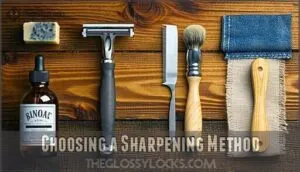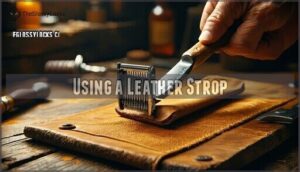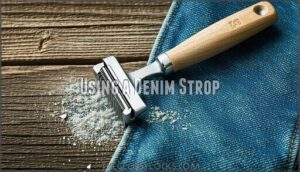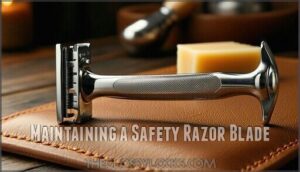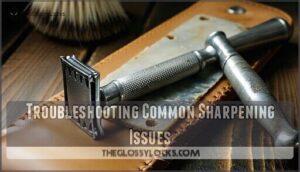This site is supported by our readers. We may earn a commission, at no cost to you, if you purchase through links.
 You can sharpen a safety razor blade using four effective methods.
You can sharpen a safety razor blade using four effective methods.
Start by cleaning the blade with hot water and rubbing alcohol to remove debris.
For sharpening, use a leather strop with 15-20 strokes per side at a 30-degree angle, or try a sharpening stone with 3000-8000 grit at 10-15 degrees.
Household items work too—run the blade along denim jeans or use a razor blade sharpening kit for consistent results.
These techniques realign the blade’s edge and extend its life by weeks, saving you money on replacements, which is the secret to maintaining the blade.
The secret lies in maintaining the right angle and pressure throughout the process.
Table Of Contents
- Key Takeaways
- Preparing a Safety Razor for Sharpening
- Choosing a Sharpening Method
- Sharpening a Safety Razor Blade
- Stropping a Safety Razor Blade
- Maintaining a Safety Razor Blade
- Troubleshooting Common Sharpening Issues
- Protecting a Safety Razor Blade From Corrosion
- Knowing When to Replace a Safety Razor Blade
- Frequently Asked Questions (FAQs)
- How do you sharpen a safety razor blade?
- How do you use a safety razor?
- How to keep disposable razors sharp?
- What is the cheapest way to sharpen a razor?
- Should you sharpen dull razor blades?
- How do I keep my razor sharp?
- Can a safety razor blade be sharpened?
- How to sharpen razors at home?
- How to keep safety razor blades sharp?
- How to sharpen a razor without a sharpener?
- Conclusion
Key Takeaways
- Clean before sharpening – You’ll get better results when you remove soap residue, hair, and mineral deposits with hot water and rubbing alcohol before starting any sharpening method.
- Master the stropping technique – You can extend blade life by 7-8 shaves using a leather strop, denim jeans, or canvas at a 30-degree angle with 15-20 light strokes per side.
- Use proper angles and pressure – You’ll maintain the blade’s edge when you keep a consistent 10-15 degree angle on stones or 30 degrees on strops with light, steady pressure throughout the process.
- Store and maintain correctly – You’ll prevent rust and dulling by drying blades completely after each use, storing them away from bathroom humidity, and applying a thin coat of mineral oil for protection.
Preparing a Safety Razor for Sharpening
Before sharpening your safety razor blade, you’ll need to prepare it properly to guarantee the best results.
Start by thoroughly cleaning the blade to remove any hair, soap residue, and mineral deposits that could interfere with the sharpening process.
Cleaning The Razor Blade
Before sharpening your safety razor, you’ll need to remove built-up grime that dulls the blade’s edge. Start with proper razor sanitizing using warm, soapy water to break down oils and debris.
Follow these blade cleaning steps:
- Rinse the razor under hot water to loosen soap residue and hair
- Soak in soapy water for 15-30 minutes, swirling occasionally
- Use a soft brush for thorough blade debris removal
- Apply rubbing alcohol for razor sanitizing and disinfection
- Inspect closely for remaining buildup or mineral deposits
Drying The Razor Blade
After cleaning comes the vital step of water removal. Proper drying prevents rust and maintains blade sharpness for effective razor blade maintenance.
Shake off excess moisture first, then pat dry with a lint-free cloth.
| Drying Method | Best For |
|---|---|
| Lint-free cloth | Quick water removal |
| Air drying | Thorough moisture elimination |
| Gentle patting | Preventing blade damage |
| Hair dryer (cool) | Fast drying process |
| Cotton swabs | Hard-to-reach areas |
Complete razor dryness is essential before blade storage to guarantee superior safety razor care and ensure proper drying and blade sharpness.
Removing Debris and Mineral Deposits
Water spots and mineral deposits turn your blade into a dull mess.
Mineral deposits and soap scum are your blade’s worst enemies, turning sharp edges into useless metal
Here’s your debris removal game plan:
- Soak the razor in warm soapy water for 10 minutes to loosen buildup
- Scrub gently with a soft toothbrush using circular motions for thorough mineral cleaning
- Apply rubbing alcohol with a cotton swab for razor sanitizing and corrosion prevention
This blade maintenance step prevents water spotting before you sharpen safety razor blades effectively.
Choosing a Sharpening Method
When sharpening your safety razor blade, you have four proven methods to choose from: sharpening stones, honing strops, razor blade sharpening kits, or using denim and canvas as makeshift strops.
Each method works differently, so pick the one that matches your tools and experience level.
Using a Sharpening Stone
For ideal razor blade sharpening, hold your safety razor at a 10-15 degree stone angle against the sharpening surface.
Use 3000-8000 grit stones for best results.
Apply light, steady pressure while sliding the blade edge across the stone with 8-12 alternating strokes per side.
Start with coarse stones for initial sharpening, then progress to fine stones for precision edge honing.
Clean your stone beforehand and maintain consistent contact for effective razor care and sharpening tips.
The quality of sharpening stones substantially affects the sharpening outcome.
Using a Honing Strop
Honing strops offer precision when you sharpen safety razor blades through careful technique and material selection.
Strop Materials and Honing Techniques determine your success.
- Leather strops provide smooth surfaces for fine edge alignment
- Denim strops offer rougher textures for initial sharpening motion
- Canvas strops warm blades while removing microscopic debris
Maintain consistent blade angles at 30 degrees throughout each stroke.
Use light pressure with 15-20 strokes per side for ideal results
Using a Razor Blade Sharpening Kit
Razor blade sharpening kits offer Kit Selection precision for your blades.
Blade Alignment at a 35-degree Sharpening Angles matters—position your safety razor correctly on the leather honing pad.
Edge Honing happens through upward sweeping motions.
Kit Maintenance keeps tools working longer.
These sharpening tools and techniques deliver consistent results.
Understanding proper razor blade sharpening is vital for peak performance.
| Feature | Kit Advantage | Your Benefit |
|---|---|---|
| Leather Pad | Perfect angle guide | Professional results |
| Compact Size | Easy storage | Always accessible |
| Durability | Lasts for years | Money saved |
| Precision | Controlled sharpening | Safer blade handling |
Using Denim or Canvas as a Strop
Everyday materials like denim or canvas work surprisingly well for blade honing.
These household items provide the perfect texture for edge polishing without expensive equipment.
- Choose your strop materials: Old jeans work best for denim stropping, while canvas offers firmer resistance
- Set up properly: Lay fabric flat on a hard surface, ensuring no wrinkles affect stropping techniques
- Execute smooth strokes: Run the razor with blade direction 10-20 times using light pressure
- Maintain consistency: Keep the same angle throughout to sharpen safety razor effectively
This canvas sharpening method extends blade life substantially.
Sharpening a Safety Razor Blade
Once you’ve prepared your safety razor blade properly, you’re ready to sharpen it using one of several effective methods.
Each technique requires specific tools and techniques, but all can restore your blade’s cutting edge when done correctly.
Method 1 – Using a Sharpening Stone
Using a sharpening stone transforms your dull safety razor into a precision cutting tool.
Blade prep starts with proper stone angle – hold your razor at 10-15 degrees against the stone surface. Apply light pressure while sliding the blade across in smooth strokes.
Complete 8-12 passes per side for effective edge honing. This razor sharpening method requires patience and steady hands for ideal results.
To achieve the best results, understanding stone selection techniques is vital for maintaining your razor’s edge.
Method 2 – Using a Honing Strop
A leather strop brings your safety razor back to life. This traditional honing method realigns blade edges without removing metal.
Position your blade at a 30-degree angle and pull it across the leather using light pressure.
Essential honing techniques:
- Start with suede side – removes microscopic burrs
- Finish on smooth leather – polishes the edge
- Use 15-20 strokes per side – maintains consistent results.
This sharpening method extends blade life substantially compared to basic cleaning alone.
Method 3 – Using a Razor Blade Sharpening Kit
When you’re ready to step up your sharpening game, a razor blade sharpening kit offers precision and consistency.
These kits provide a leather honing pad designed for ideal blade alignment and edge honing.
| Component | Purpose | Benefit |
|---|---|---|
| Leather pad | Provides consistent surface | Even sharpening angles |
| Guide system | Maintains blade alignment | Prevents edge damage |
| Instructions | Shows proper technique | Maximizes kit effectiveness |
Position your safety razor at the recommended sharpening angles (typically 30-35 degrees), then glide the blade along the strop materials with light pressure.
These razor sharpening methods extend blade life substantially compared to standard razor blade sharpening methods.
Understanding proper razor blade sharpening techniques is vital for maintaining a sharp edge and extending the life of your razor.
Alternative Methods for Sharpening a Safety Razor
Beyond sharpening kits, household items work well for razor blade sharpening methods.
Try these strop alternatives:
- Denim stropping – Run your blade across old jeans 10-20 times to realign edges and extend blade life
- Ceramic sharpening – Use an unglazed mug bottom as a razor hone for maintaining proper blade angle
- Canvas stropping – Provides mild abrasion that cleans and hones the edge through repetitive strokes
These sharpening methods offer practical stropping techniques without specialized equipment.
Stropping a Safety Razor Blade
Stropping realigns your safety razor blade’s edge without removing metal, making it sharper than when you first bought it.
You’ll need a leather strop, denim, or canvas surface to perform this essential maintenance step.
Using a Leather Strop
When perfecting your razor blade sharpening routine, leather strops excel at edge alignment and blade honing.
Start with the suede side for initial stropping techniques, then finish on smooth leather for ideal sharpness maintenance. Apply light pressure while maintaining a consistent 30-degree angle across leather strop materials.
Regularly cleaning and maintaining the razor with proper blade hygiene practices can substantially extend its lifespan and effectiveness.
Strop Type Maintenance Tips Care Essentials
Strop wisely and enjoy smoother shaves!
Using a Denim Strop
Old jeans work perfectly for denim strop maintenance. Place jeans on a flat surface and run your blade along the fabric with light pressure.
Denim Strop Tips for effective blade maintenance:
- Use 20 quick strokes per side following blade direction
- Keep consistent angle to maintain razor edge sharpness
- Apply gentle pressure to avoid damaging the blade
This sharpening tricks method costs nothing and extends blade life substantially.
Using a Canvas Strop
Canvas strops provide excellent blade alignment and edge preparation between leather stropping sessions.
The canvas texture gently cleans debris while warming the metal for ideal edge polishing.
Run your blade across the canvas using long, smooth strokes in the same direction as the cutting edge.
Canvas Care essentials for effective stropping:
- Choose quality materials – Select linen or cotton canvas strops designed specifically for razor maintenance and sharpening methods and tools.
- Maintain consistent pressure – Apply light, even pressure while stropping to avoid damaging the delicate blade edge during sharpening tips application.
- Keep canvas clean – Remove debris regularly from your strop materials to prevent contamination that could dull your freshly sharpened safety razor blade.
Stropping Techniques for a Sharp Edge
Master stropping techniques with smooth, controlled movements at the right angle.
Hold your strop safety razor at 30 degrees and perform 15-20 gentle strokes per side.
Leather strops provide classic edge refining, while denim sharpening offers accessible razor maintenance.
Light pressure matters more than force—consistent stropping transforms dull blades into sharp performers through proper sharpening techniques.
Maintaining a Safety Razor Blade
Proper maintenance keeps your safety razor blade sharp for weeks instead of days. Follow these four essential practices to maximize blade life and performance.
Proper Storage of Razor Blades
After sharpening your blade, proper blade storage becomes critical for maintaining that razor-sharp edge.
Store blades in Dry Storage locations away from bathroom humidity. Blade Cases or Razor Vaults protect against dust and moisture.
Consider these storage essentials:
- Use Sharp Lockers or Blade Safes for organization
- Apply thin oil coating before storage
- Keep away from shower areas
- Store in cool, dry cabinets
- Check stored blades regularly
Proper razor blade storage extends blade longevity substantially, making blade replacement and assessment less frequent while helping you sharpen safety razor blades more effectively.
Regular razor maintenance tips can also improve the overall shaving experience.
Cleaning and Drying After Use
After proper storage comes the daily upkeep that keeps your blade sharp longer.
Clean your safety razor with warm water after each shave to remove soap residue and whiskers. Pat it completely dry with a clean towel – moisture is your blade’s worst enemy.
- Razor Sanitizing: Rinse thoroughly under warm water to eliminate bacteria and buildup
- Water Removal: Shake off excess moisture, then towel-dry completely for blade care
- Dry Storage: Place in ventilated area away from humidity for proper maintenance
Regular Honing and Stropping for Maintenance
The secret to a sharp safety razor lies in consistent maintenance routines.
Honing every 5-10 shaves removes microscopic damage, while stropping weekly realigns your blade’s edge.
Use proper blade angles—30 degrees works best.
Leather strop materials excel for edge realignment, though denim provides excellent results too.
This sharpening frequency extends blade life substantially.
Stropping
Blade Check
Inspecting The Blade for Damage
Before each use, examine your safety razor blade for signs of wear that could affect razor blade sharpness.
Look for metal flaking along the cutting edge, rust detection on the surface, and edge wear from repeated use.
Check for nicks, chips, or jagged areas during your blade inspection routine.
Proper damage check habits prevent poor shaves and maintain effective blade maintenance for safety razor sharpening success.
Troubleshooting Common Sharpening Issues
Even experienced shavers encounter challenges when sharpening safety razor blades. You’ll face issues like uneven edges, damaged blades, or stubborn nicks that require specific solutions to restore peak sharpness.
Uneven Sharpening
When your razor blade develops uneven edges, Angle Control becomes your best friend.
Maintain a steady 30-degree angle throughout each stroke.
Edge Alignment suffers when pressure varies, so keep your Sharpening Technique consistent.
Regular Blade Inspection helps catch problems early, while quality Strop Material guarantees even results when you sharpen safety razor blades.
- Frustration mounts when one side cuts perfectly while the other tugs
- Disappointment strikes when your honing strop work goes sideways
- Relief floods in once you master consistent sharpening stone technique
Damaged or Worn-Out Blades
When metal fatigue sets in, your blade shows clear warning signs.
Look for excessive dullness that won’t respond to blade sharpening efforts, visible rust spots indicating corrosion control failures, or persistent tugging during shaves.
These damaged blades can’t be saved through razor blade sharpening techniques alone.
Dullness Replace
Rusting
Pulling
Edge restoration becomes impossible once wear prevention has failed completely.
Nicks and Chips on The Blade
Small nicks and chips happen during normal shaving but don’t spell doom for your blade.
Light blade damage can be fixed through careful nick removal using a sharpening stone at proper angles.
Start with gentle strokes to prevent metal flaking and focus on edge restoration. Minor chip repair works well with honing strop techniques.
However, deep gouges or extensive damage means it’s time to replace the blade entirely, as this type of damage cannot be fixed with simple edge restoration.
Resolving Common Sharpening Problems
Most sharpening problems stem from poor technique.
Here’s your troubleshooting roadmap for razor blade sharpening issues:
- Check your angle – maintain 30 degrees consistently to prevent uneven sharpening
- Clean thoroughly – remove all residue before sharpening to avoid edge damage
- Use proper pressure – light, steady strokes prevent blade warping and nicks
- Rotate regularly – alternate sides and directions for uniform edge repair
These sharpness tips will solve most razor maintenance headaches.
Protecting a Safety Razor Blade From Corrosion
Corrosion can destroy your safety razor blade faster than dull cutting edges, turning sharp steel into rusty metal that irritates your skin.
You’ll need to protect your blade from moisture and air exposure using simple techniques that add weeks to its usable life.
Using Mineral Oil or Cooking Oil
Protecting your blades from rust starts with proper oil applications.
Apply a thin layer of mineral oil after each sharpening stone session to create effective blade coating. This mineral protection forms a barrier against moisture and air exposure.
Simply dab the oil onto clean blades, ensuring even coverage for ideal razor lubrication. The oil displaces water molecules that cause corrosion prevention issues. Let excess oil evaporate before storage.
Regular use of mineral oil can lead to improved mineral oil benefits.
Mineral Oil
Applying a Protective Coating
Professional coatings transform your safety razor into a corrosion-resistant powerhouse.
These protective barriers block moisture and oxygen from reaching the blade’s metal surface, extending its lifespan substantially.
Here are four proven coating options for blade protection:
- PTFE (Teflon) coating – reduces friction and provides excellent corrosion control
- Chromium plating – creates a hard, durable surface that resists rust formation
- Titanium nitride coating – offers superior metal protection with extended service life
- Platinum coating – delivers premium corrosion resistance for long-term blade maintenance and care
When selecting a coating, consider the titanium alloy benefits to guarantee durability and performance.
Storing The Razor in a Dry Environment
Moisture ruins razor blades faster than frequent use.
Humidity kills your blade faster than a hundred shaves ever could
Store your razor in a bedroom dresser or hallway closet instead of the steamy bathroom.
Blade cases and razor cabinets offer excellent humidity control for your storage solutions.
Keep blades away from shower areas where water droplets linger. A simple drawer provides better dry environment conditions than bathroom countertops for proper blade storage, ensuring a longer life for your razor through proper blade storage and avoiding the steamy bathroom.
Avoiding Corrosion With Regular Maintenance
Regular maintenance acts as your razor’s shield against rust and corrosion.
Follow these essential steps:
- Clean thoroughly after each shave with warm water and soap
- Dry completely using a lint-free cloth to remove all moisture
- Apply protective coating with mineral oil or specialized blade fluid
Store your razor in a dry cabinet away from bathroom humidity.
This simple routine prevents oxidation and extends blade life substantially through proper corrosion control and metal protection.
Knowing When to Replace a Safety Razor Blade
Even the sharpest blade won’t last forever, and knowing when to replace your safety razor blade is essential for maintaining an effective shave.
While sharpening techniques can extend blade life substantially, recognizing the signs of irreversible wear will save you from tugging, irritation, and poor shaving performance.
Signs of a Dull Blade
Your dull razor gives clear warning signs before it fails completely.
Watch for these Dull Blade Signs that indicate sharpening issues with your safety razor blades:
- Razor Tug – Your blade pulls and drags instead of gliding smoothly through whiskers
- Uneven Shave – Patchy results where some areas stay stubbly despite multiple passes
- Blade Wear – Visible nicks, chips, or Rust Formation along the cutting edge
When your dull razor starts tugging, it’s fighting you instead of working with you.
Frequency of Use and Blade Life
Understanding blade longevity helps you sharpen safety razor blades effectively and extend blade life. Most users change blades after five to seven shaves, though usage patterns vary.
Daily shavers typically replace blades weekly, while occasional users swap them biweekly. Proper blade storage techniques can substantially impact the lifespan of your safety razor blades.
| Hair Type | Shaves Per Week | Blade Life |
|---|---|---|
| Coarse | 5-7 | 5 days |
| Medium | 3-5 | 7 days |
| Fine | 1-3 | 14 days |
Blade wear depends on shave counts and hair thickness. A razor blade sharpener can prolong razor life when you maintain razor edge properly.
Assessing The Condition of The Blade
Beyond surface wear, inspect your blade’s condition through systematic blade inspection methods.
Check for edge damage along the cutting surface and examine for metal corrosion or rust spots.
- Nicks and chips – Small imperfections that catch light differently
- Rust patches – Orange or brown discoloration indicating oxidation
- Bent edges – Warped metal from improper handling or storage
- Dull spots – Areas where the blade feels rough during a sharpness test
Use good lighting and magnification when possible for thorough blade maintenance assessment.
Replacing The Blade for Optimal Performance
When blade replacement becomes necessary, swap out your safety razor blade promptly to maintain superior shaving performance.
Fresh blades deliver superior sharpness tests results compared to worn edges.
Replace blades showing rust, nicks, or reduced cutting ability during edge inspection.
Proper blade replacement prevents skin irritation and guarantees consistent shaves.
Quality razor blade replacement extends your razor’s blade lifespan while supporting effective blade maintenance and rust prevention practices.
Frequently Asked Questions (FAQs)
How do you sharpen a safety razor blade?
Like sharpening a pencil brings words to life, reviving your safety razor blade restores its cutting edge.
Strop the blade on old denim using twenty quick strokes in each direction, maintaining light pressure and proper angle throughout, to effectively restore its functionality.
How do you use a safety razor?
Hold your safety razor at a 30-degree angle against wet, lathered skin.
Use short, gentle strokes with the grain.
Don’t press hard—let the razor’s weight do the work for smooth results.
How to keep disposable razors sharp?
Keep disposable razors sharp by stropping them backward on denim jeans using light pressure. Run the blade against the grain fifteen times, then rinse and dry thoroughly after each shave.
What is the cheapest way to sharpen a razor?
Your wallet won’t cry when you strop that razor on old denim jeans. Simply run the blade twenty quick strokes each direction using light pressure for restored sharpness.
Should you sharpen dull razor blades?
Yes, you should sharpen dull razor blades. Sharpening extends blade life by 7-8 additional shaves, saves money, reduces waste, and maintains comfortable shaving performance instead of tolerating tugging and irritation.
How do I keep my razor sharp?
Clean your razor after each use with warm water and soap.
Dry it completely to prevent rust.
Strop on denim or leather using light pressure for fifteen strokes per side to maintain sharpness.
Can a safety razor blade be sharpened?
You can sharpen safety razor blades using stropping techniques on denim, leather, or even your forearm.
Run the blade 15-20 times in one direction with light pressure to realign the edge and extend blade life substantially.
How to sharpen razors at home?
Like giving new life to a tired blade, you can sharpen razors using old denim jeans, leather strops, or your forearm.
Run the blade 20 times in each direction with light pressure for best results.
How to keep safety razor blades sharp?
Store your blades in a dry place away from humidity.
After each shave, rinse thoroughly and dry completely with a clean cloth.
Regular stropping on denim or leather maintains the edge between uses.
How to sharpen a razor without a sharpener?
You’ll use everyday items like old jeans, your forearm, or an unglazed ceramic mug.
Run the blade along jeans twenty times each direction using light pressure, maintaining the blade’s angle for effective stropping.
Conclusion
Studies show that properly maintained safety razor blades can last 300% longer than neglected ones.
Learning how to sharpen a safety razor transforms your daily routine and budget. These four methods—leather strops, sharpening stones, household denim, and specialized kits—extend blade life substantially.
You’ll notice improved shave quality and reduced irritation with consistent practice. Regular maintenance prevents premature replacement and saves money long-term.
Master these techniques to keep your safety razor performing at its best for weeks instead of days, and enjoy the benefits of reduced irritation, consistent practice, and properly maintained safety razor blades.
- https://wildeandharte.co.uk/blogs/post/sharpening-razor-blades
- https://www.nakedarmor.com/blogs/news/how-long-do-safety-razor-blades-last
- https://www.youtube.com/watch?v=yOHeb6EFSrI
- https://www.etsy.com/market/razor_blade_sharpener
- https://grownmanshave.com/blogs/grown-man-shave-society-articles/how-often-should-you-change-your-safety-razor-blade

